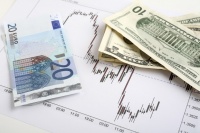Short-term trading idea FX EUR/USD – bear speculation: rebound from the upper boundary of the A-A channel

Trading opportunities for the currency pair: The price is trading around the upper boundaries of the A-A and C-C channels. On the monthly timeframe, there’s a risk of falling to 1.25, but the euro is expected to strengthen significantly from September onwards. In connection with this, the range from 1.1475 to 1.1595 will be used for selling euros, with targets of 1.12 and 1.0925. If, from September, the price continues to trade above 1.1290, it would be wise to close all short positions. In such a case, buyers will push the price to 1.25 to the upper boundary of the D-D channel. If we get a breakout of the C-C channel in July, it’s worth changing our target from 1.25 to 1.27.
Background
The previous idea on the EUR/USD pair was published on the 13th of March, 2016. At the time of publication, the euro was trading against the dollar at 1.0670. After February’s payrolls (from 10/03/17), the price came out of the 1.0494 – 1.0626 range. I was expecting growth to 1.0780 after a breakout of 1.0715 level. With no rebound from 1.0780 and a breakout of the 1.0829 resistance, I was expecting the rate to rise to 1.1021 by the 10th of April. This worked out by way of a deep correction from 1.0906 to 1.0569. The price reached the TR1 line on the 4th of May, hitting 1.1021 on the 8th of May.
Current situation
On Friday, the 7th of July, the euro/dollar pair closed down. There was a lot of activity on the market as the nonfarm payrolls report was released. The rate first reacted with a 20-pip drop to 1.1384, followed by a 57-pip surge to 1.1440. These sharp fluctuations lasted for about 5 minutes. Once market volatility had subsided, the euro hit its session low within 30 minutes.
In June, the US created 222,000 new jobs outside the agricultural sector after a forecast of 170,000. The figure for April was revised from 174,000 to 207,000 and for May from 138,000 to 152,000. The aggregate revision for the two months comes to +47,000.
The workforce participation rate grew from 62.7% to 62.8%. Unemployment rose slightly from 4.3% to 4.4% (forecast: 4.3%). The average hourly earnings index for the US in June grew by 0.2% (forecast: 0.3%, previous reading revised from 0.2% to 0.1%).
The dollar’s growth was initially held back by the weak growth in hourly earnings. As we can see from the session’s end, traders were refusing to sell their dollars. The euro/dollar rate closed at the 1.1400 mark. The dollar received some additional support from a growth in bond yields.
Below, I’ve tried to lay out a forecast for this currency pair for the next two months. Let’s start with the monthly timeframe.

Monthly chart. Source: TradingView
The monthly graphic paints a very interesting technical picture. The price is currently trading around the upper boundary of the C-C channel, which is located inside the long-term downwards D-D channel. On the left of the chart, I’ve inserted a graphic showing the pair’s price movements between 1998 and 2004. The M-model with three bases that runs from September 2000 to August 2002 and the one that goes from March 2017 to June 2017 are interesting to compare.
The upper boundary of the C-C channel is located at around 1.1595/1.1600. I think that the zone from 1.1475 to 1.1600 is a sell zone for the euro. If the pair moves towards the trend line of the D-D channel at 1.25, it’ll be after a rebound. By my calculations, I see the downwards correction lasting until the 29th of September this year.
The ECB’s optimistic outlook is providing support for the euro, so during the correctional phase, we need to look at how quickly the rate drops. The faster the price returns to 1.0915, the higher the probability of it falling as far as the lower boundary of the C-C channel.

Weekly chart. Source: TradingView
I showed you the major channels on the monthly chart. On the weekly chart, we’ll look at some separate details. I haven’t shown the C-C channel previously as there was no real need. For me, the resistance came from the upper boundary of the A-A channel, which ran through the maxima 1.1714 (28/08/16) and 1.1616 (03/05/16).
Growth slowed down around 1.1446. On the C-C channel, the target for bulls is around 1.1595/1.16. While the price is trading within this channel, international banks are keeping quiet about the technical targets for the euro at 1.25. Also, a strengthening euro in the case of a discrepancy between the monetary policies of the Federal Reserve and ECB hasn’t been accounted for in this scenario.
With the ellipsis at point 3, I’ve shown the area where a reversal candlestick will form from the 10th to the 28th of July between 1.14 and 1.1595. During this time, we should see the formation either of a pin bar or a bearish engulfing.
The NFP report on Friday stopped buyers in their tracks. It only has a short-term effect, so it’ll be interesting to see where the euro closes on Monday and Tuesday. Judging by the weekly candlestick, the euro bulls are set to move upwards.
Point 1: a projection of a fall from 1.1714 in case of a strengthened downwards correction from 1.1446.
Point 2: a projection of a fall from 1.1616 in case of a strengthened downwards correction from 1.1446.
It would be a good sign for sellers if the price returned to 1.1190 by the 17th of July. A long consolidation phase (until the end of July) above 1.1290 will be indicative of intention from euro bulls to break 1.16.

Daily chart. Source: TradingView
The NFP report halted the euro bulls for a time. On Friday, the euro/dollar pair closed down. I’ve kept the same format on the daily chart as I used for the weekly chart. Here, I’m stopping at the zone from 1.1290 – 1.1312 and 1.1230 level (support from the b-b channel). A breakout of this zone would trigger a double top model. A breakout of 1.1230 would open the way towards 1.1120 and 1.0919 (point 2).
If the A-A channel is broken through, we can expect growth up to 1.1595. Buyers will be difficult to stop here. The latest COT report seems to agree with this, which shows that in the last week, (up to and including the 4th of July) large and small speculators increased their long positions on the euro while reducing short positions.
So, what we can we expect now? As we see from the monthly timeframe, there’s a high risk of going up to 1.25. While the pair is trading inside the A-A and C-C channels, the 1.1475 – 1.1595 range will be used for selling euros with targets of 1.12 and 1.0925. Cycles indicate that strong growth should start from the 29thof August until the 22nd of September (the vertical zone of the chart). If the price keeps trading above 1.1290 during this time, it would be worth closing all short positions. In such a case, buyers will push the price to 1.25 to the upper boundary of the D-D channel. If we get a breakout of the C-C channel in July, it’s worth changing our target from 1.25 to 1.27.
Source ALPARI


